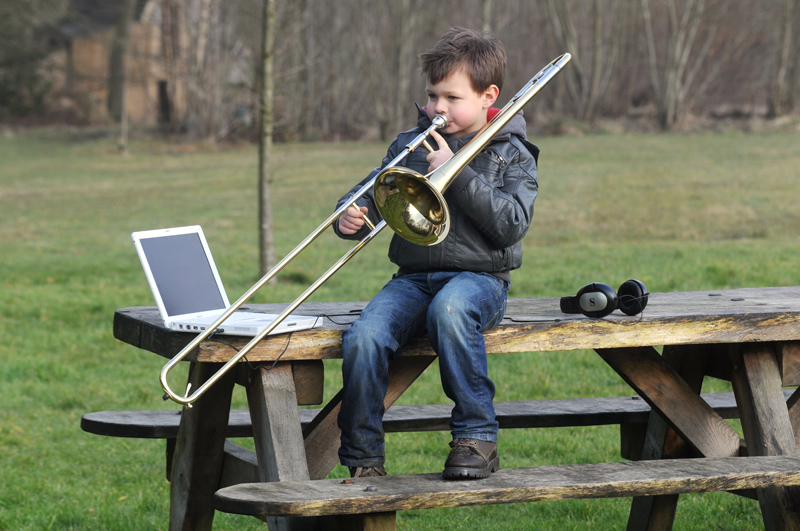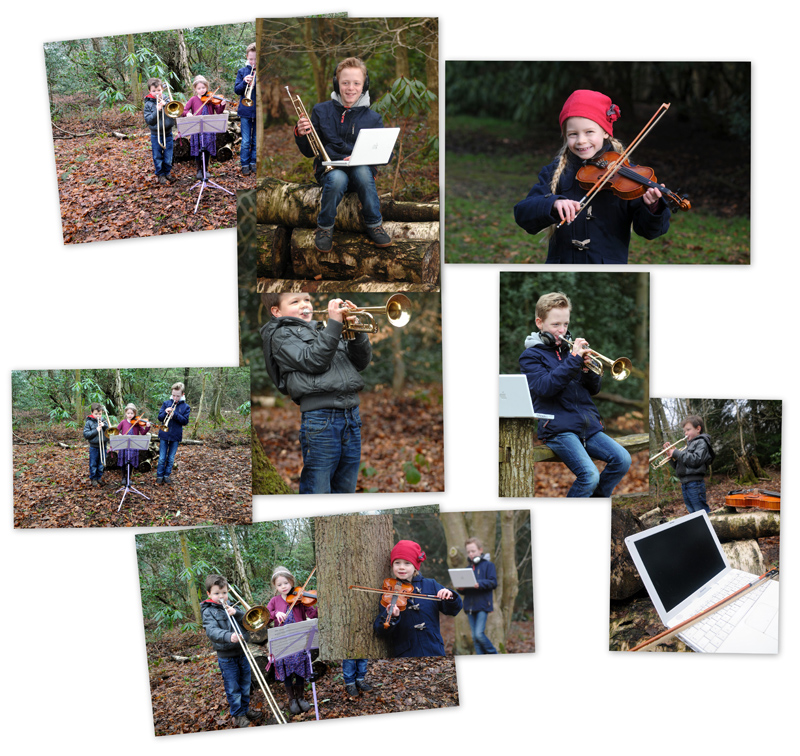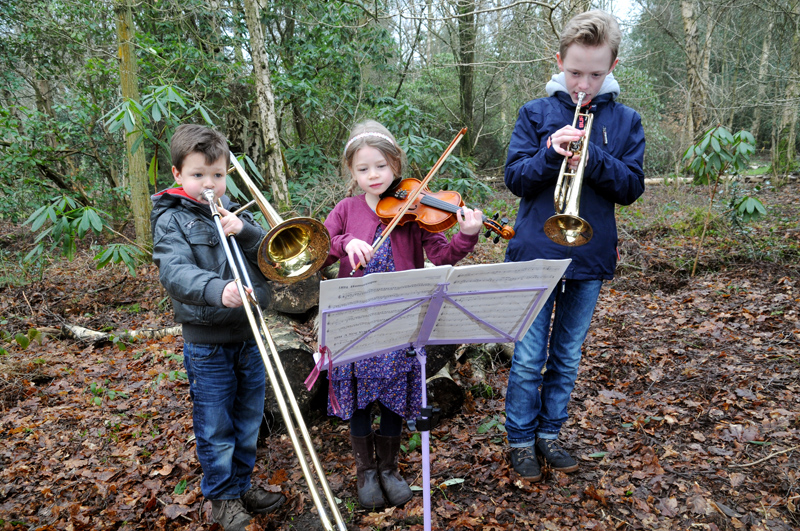Bringing music making to students in remote rural areas.
The overarching intention has been to develop a model of effective practice that is relevant to Music Education Hubs and similar organisations across the country. Now being implemented in partnership with several Hubs across the country, this case study report focuses on the pilot project, provided by the North Yorkshire Music Hub with support from the Digital R & D Fund for the Arts.
Description
Connect Resound brought together music development charity NYMAZ ( http://www.nymaz.org.uk ), music technology in education specialists, UCan Play ( http://www.ucanplay.org.uk ), and specialist researchers from the University of Hull to work with the North Yorkshire Music Hub ( http://www.northyorkshiremusichub.co.uk ) to explore and develop new solutions for improving access to music education opportunities for learners in remote and rural parts of the county.

North Yorkshire Music Hub aims to ensure that all children in the Hub area have access to music tuition in and out of school. This includes the provision of instrumental and vocal tuition to pupils throughout North Yorkshire through the County Music Service. North Yorkshire, as a largely rural county, faces a number of transport, logistical and cost issues relating to the provision of a diverse, high quality and accessible range of opportunities to all pupils in the county. The advent of reliable and affordable technology, and improved internet connectivity, offers Hubs covering large rural areas, such as North Yorkshire, the opportunity to explore new ways of overcoming these issues.
The project was designed to explore ways in which new technology could be integrated into the Hub's existing programme of instrumental and music education and enrichment opportunities, in order to enhance access, particularly for rurally based schools and learners.
The first strand of the project was trialling the provision of instrumental lessons online, using different configurations of affordable, good quality audio-visual equipment and video conferencing software to establish the most effective approach. The team worked with seven Primary schools, focusing on Key Stage 2 pupils, providing twice weekly, 20-minute long, online instrumental lessons over a period of 7 weeks. Pupils were at beginner stage, and were taught a variety of instruments that included clarinet, guitar, violin and trumpet, in individual or small group lessons. Lessons were provided during the school day by the County Music Service peripatetic music teachers.
I think its important to give every child the opportunity to learn a musical instrument, and that's very difficult in a rural school
The project team identified a technical setup comprising a Roland VR-3EX video and audio mixer and streamer, three cameras and external microphones. The equipment was used in addition to Skype, and was sourced with best value as well as quality of sound and image in mind.
The project trialled four different configurations of the technology used during instrumental lessons for schools as below in order to assess if one was more effective than the others:
- Teacher : VR-3EX + Cameras and Mics | School : VR-3EX + Cameras and Mics
- Teacher : VR-3EX + Cameras and Mics | School : PC/Webcam and Skype
- Teacher : PC/Webcam and Skype | School : VR-3EX + Cameras and Mics
- Teacher : PC/Webcam and Skype | School : PC/Webcam and Skype
The research team compared the effectiveness of these setups to traditional face-to-face instrumental teaching, in order to assess the quality of teaching that could be achieved online, and also to compare the different configurations as listed above.
Connect: Resound also explored ways in which the core technical setup of Audio/Visual Mixer and Streamer, Cameras and Mics could be used to enable the provision of related music education and enrichment activities, such as the live broadcast of music performances, and CPD and training for music leaders and teachers.
What is the context of the work?
Connect: Resound responded directly to the recommendation made in Darren Henley's 2011 Review of Music Education ( https://www.gov.uk/government/publications/music-education-in-england-a-review-by-darren-henley-for-the-department-for-education-and-the-department-for-culture-media-and-sport ) that future research should '…examine how technology could enable better teaching of music (particularly in rural communities)'.
The action research pilot of Connect: Resound was established as a critical first step on a longer journey to explore the role that technology can play in improving access to high quality music education for children in rurally isolated areas.
The project was led by NYMAZ for the North Yorkshire Music Hub. The County Music Service porvided the teaching, UCan Play led on the technical developments and training, and the University of Hull was the lead research partner.
Lessons took place in 7 Primary schools across North Yorkshire, in rural and semi-rural locations. 71 pupils aged 7 – 11 took part in the pilot instrumental lessons. The live broadcast music performances were available to all Primary and Secondary schools in the county. Online CPD and training in the use of the technology and web-based teaching were provided to music teachers and leaders in the North Yorkshire area.
By comparing and testing different approaches, the intention was to develop a pedagogic model that could be implemented as part of the core business of North Yorkshire, and subsequently rolled out to other Music Education Hubs across the country.
What is the content of the work?
The central focus of the pilot Connect: Resound project was the provision of instrumental lessons online. The lessons themselves were no different in essence to those provided every day by North Yorkshire Music Service's experienced team of peripatetic music teachers. Pupils at an early stage in their instrumental learning were taught violin, guitar, clarinet or trumpet in individual or small group lessons of 20 minutes, purely over the internet. The lessons were observed and compared to the service's customary face-to-face lessons.
The lessons are really enjoyable and make me want to learn my flute every minute of every day and I'm so glad I got the opportunity...
As described above, each school trialled a different technical setup, in order that the effectiveness of the different approaches could be compared. The research partners assessed both technical and pedagogical aspects using lesson observation, questionnaires, and interviews with participants—teachers, music leaders, pupils and parents.
As with instrumental lessons, there are myriad transport, logistical, cost and cultural factors that can affect the level of access that young people in rural areas have to music and other cultural performances, and for their schools to facilitate such access. In addition to instrumental tuition, Connect: Resound used the same technology setup developed for the schools programme for live broadcast music performances and events online. Access to these broadcasts was offered to all schools in North Yorkshire. Connect: Resound worked with Musicport, Grassington Festival, and Harrogate International Festivals to develop a diverse programme of live music broadcasts. These encompassed live concert performances of acoustic/folk and classical music, in addition to a live, behind-the-scenes look at life in a band. This broadcast provided an insight into rehearsal and recording processes and helped pupils to understand the link between learning an instrument at school and the range of professional, creative and social opportunities afforded by this experience in later life.

These performances were recorded and broadcast using the same technology set up as for the on-line instrumental tuition, with the addition of an extra camcorder to enable tracking and mobile shots. The broadcasts used both wired internet connection and 4G signals, and performances were made available via YouTube.
Finally, the CPD strand involved training school staff and volunteers, as well as Music Hub music leaders and managers, in using broadcast technology and teaching music lessons online. The project also trialled presenting CPD opportunities online, recognising the fact that music leaders in the County can find it hard to access those opportunities that are available, due to transport and cost difficulties.
What are the key features of the teaching and learning approach?
The instrumental teachers volunteered to take part in the project with a great deal of interest and enthusiasm. Training in using the equipment, and in teaching an instrument online, was provided by technology and music education specialists from UCan Play, who were also responsible for installing the technology in each location.
Connect: Resound did not set out to change the way in which peripatetic teachers lead instrumental learning; the essentials of each lesson were the same as if the tuition had been taking place face-to-face, including lesson duration, teaching methods and resources used. Teachers received education in using the technology and preparing for lessons, but planned and taught their lessons according to their usual practice.
However, during the project, teachers and researchers captured what was different about teaching online, and the key pedagogical issues that arose. Overall, teachers found that beginner technique demonstrated well online. When the additional technology was not used, and teaching was provided via a Skype to Skype connection, the teaching of instrumental techniques such as violin bow hold was seen to be more difficult. Assembling instruments could have been a potential issue and teachers developed protocols to address this challenge. Tuning instruments presented difficulties, but, again, teachers developed strategies to deal with this using online apps – whilst also recognising the benefit in getting pupils used to tuning their own instruments early on.

The use of the Roland VR-3EX allowed up to three different camera angles to be used at either the teacher, or the pupil location, depending upon the approach used. The figure (below) demonstrates: an overall view of teacher or pupil (T); a mid-range view (U); and a close-up view (V). Teachers integrated the use of different camera angles into their teaching during the course of the study and by the end they were each using the different angles for a similar proportion of teaching time. By the end of the set of lessons, teachers and pupils seemed to have established specific positions for their cameras and to have switched be-tween the different views easily. This suggests that they became more comfortable with the technology at their disposal.
The research team undertook detailed analysis of the online and face-to-face lessons in their study, comparing a range of elements, including modelling behaviour, time spent asking questions, demonstrating technique, listening and observing. When compared to a control group from an existing study, the teachers involved in the online lessons spent slightly more time asking questions and less time 'modelling' – but the researchers found very little difference between the online and face-to-face lessons provided by the Music Service staff themselves. There was also no significant difference between the time that the children spent actually making music (playing and singing) in the lessons.
This opportunity has built confidence, self satisfaction, happiness and family bonding; very proud of what music has created personally for our child...
Teachers recognised—and welcomed—the benefits of online learning to support teaching, with one observing “Its so much easier – Yorkshire being massive – so actually having lessons rather than running from school to school was great!”
Over the course of the project, teachers gained an understanding of the key ingredients required for an online lesson – from thorough preparation and clear, planned communication with the school, to considerations of room layout, clothing, gesture and use of resources. This learning has been captured in blog posts, guidance for Hubs and teachers, and a webinar, Introduction to Teaching Music Online. These resources are all available on the Connect: Resound webpages ( http://www.nymaz.org.uk/connectresound ), or via the NYMAZ Remote Music Learning Network (membership is free!)
For the purposes of the action research, all teaching took place online during the pilot project. However, teachers and pupils both felt that some face-to-face interaction was preferable, with the suggestion of one face-to-face lesson at the start of each half term.
How is the work being reviewed?
Research partners, the University of Hull, were closely involved in the project from inception to delivery. An R&D methodology was developed, which would work with Primary schools across North Yorkshire to test different methodologies for online tuition, the key differences being the equipment used at the school and the teacher locations.
The overall research question was:
Can internet technologies increase the ability of Music Hubs who operate in rural areas to provide comprehensive, high quality, yet affordable music education to all children and young people?
In order to explore this question, the research team developed a set of further research questions that underpinned the project design and delivery:
- What can we learn about using online technology to provide music lessons and enrichment opportunities, such as live performances?
- What technology exists to facilitate online music education and how cost effective is it?
- How are other people using online technology to provide music education and what research exists in this area?
- How reliable is the technology?
- How do the different configurations of technology being tested compare?
- How do pupils and teachers respond to using technology for teaching music and providing music performances in this way?
- The research team observed thirteen individual lessons and eleven group lessons in week one. The final lessons were also observed and captured.
The purpose of the capture of the first and last lesson was two-fold:
- To explore how the teachers used the technology and taught in the first lesson; and
- To understand how the use of technology and teaching approach had developed by the final lesson.
Post-project interviews took place with all the instrumental teachers and feedback was sought from pupils, carers/parents, and school staff, including music coordinators and Headteachers.
The results of the data analysis demonstrated three major areas of discovery for the research team. These are based on the themes of: Technology; Provision; and Environment. The areas are not equally weighted in terms of significance, but capture the essence of what was discovered by the research team. The research findings, along with detailed project description, are available in the full Connect: Resound Research and Development report, published by the Digital R & D Fund for the Arts, and the full report as well as a summary version are downloadable from the Connect: Resound webpages on www.nymaz.org.uk
The findings have informed the next phase of Connect: Resound, as well as the detailed technical and project development and delivery guidance produced as a result of the pilot. The project has now been rolled out to four new Music Education Hubs—Cumbria, Durham/Darlington, East Riding of Yorkshire, and Cornwall—all of whom are now trialling the technology and approach in partnership with schools in their areas. Further live online broadcasts are being commissioned, as well as a programme of continuing professional development, including webinars, online discussion fora and additional guidance and training. This will culminate in a gathering in June 2016 for all those with an interest in developing music education online. The approach is being explored and implemented by other Hubs beyond the four listed here, with guidance and support from Connect: Resound, and we are facilitating practice sharing, evidence gathering and collaborative working across this emerging network.
What are the positive outcomes for children/young people – are they some or all of musical, social, personal, educational - how and when can they be identified?
- The action research demonstrated the potential of this approach for reaching greater numbers of pupils, widening access to music education and enabling the teaching of a wider range of instruments in contexts where this can be extremely challenging.
- Music learners in rural areas can have access to regular tuition on a wide range of instruments and make the same progress as they would in face-to-face lessons.
- Pupils (and their parents) reported that they enjoyed learning music in this way, and teachers said that levels of engagement and concentration were high.
- A school music co-ordinator commented: “I think its important to give every child the opportunity to have instrumental lessons, and that's so very difficult in a small rural school”.
- The project enabled children who would not otherwise have had the opportunity to learn an instrument to do so – 79% of parents said that they would not otherwise have sought out instrumental lessons for their child. Hubs feel that the approach has good potential for providing an opportunity “for those kids that…are not sure about whether they want to learn an instrument, to actually make a start”.
- An unanticipated benefit of the approach was the emergence of increased self reliance and confidence amongst the young people, who developed skills in tuning, assembling instruments, keeping the beat, and using audio-visual technology much earlier than would otherwise have been the case.
- There was a sense of involvement from the schools, with Teaching Assistants and parent governors supporting the learners and getting more involved in music lessons than may have been the case if a visiting instrumental tutor had taught the lessons.
What are the key features of teacher/leader behaviour that are enabling those positive outcomes?
Key features of teacher/leader behaviour are:
- Enthusiasm, creativity, a willingness to learn and adapt existing teaching approaches in the light of the new opportunities provided by the media;
- The sharing of experiences, hints and tips. This is hugely helpful. In some Hubs enough teachers are now providing online learning to cascade learning to others. The new national network and Connect: Resound resources are also intended to enable this practice sharing;
- Excellent planning and communication skills, ensuring that all resources and systems are in place, that everyone has key contact details, appropriate learning resources and other key information; and
- An ability to solve problems, source apps and teaching aids, and support pupils to learn and participate differently according to the needs of the teaching method.
What are the key features of context, content and activities that are enabling those positive outcomes?
The project started with clear objectives and a focused framework of provision that enabled the outcomes and learning to be captured and shared. The team set out to explore solutions to a recognised issue for many hubs, and to develop an approach that was replicable—in terms of cost, technical expertise, and commitment to quality—across other Music Education Hubs.
It's so much easier—Yorkshire being massive—so actually having lessons rather than running from school to school, that was great”...
The easier to use—and more reliable—the technology, the more positive the experience for teachers and learners. Investment in additional audio visual technology, selected especially for this application, transformed online learning compared to a Skype only approach. Superfast broadband connections are also essential, as is a willingness on the part of Hubs and schools to engage in training and to experiment with new ways of working.
Learning from previous and current practice, developing and sharing learning resources, and an open, collaborative approach, and evidence-based practice are all key features of the success of the project. Connect: Resound is developing, revising and publishing a dynamic bank of online resources, as well as providing CPD activities on and offline, and facilitating a virtual network of practitioners, in order to support and develop best practice in online music teaching in Music Education Hubs.
What other factors in this case are contributing to those positive outcomes?
There is a political will and understanding of the issues, translating to support from policymakers and funders for the project. Strong evidence from reports such as Gone In The Air, by NYMAZ, offer essential data and advocacy around the issues facing those providing music activities in rural areas:
Other factors include:
- Affordable and usable technology, with companies adept at explaining and exploring a diverse range of potential applications, not always envisaged at manufacture!
- The advent of superfast broadband in many, but by no means all, rural areas; and
- A sense of momentum and critical mass amongst those involved in music education, with a recognition of the issues and the potential to address them through new technologies and approaches.
How replicable or adaptable is it?
The overarching intention of the project was to develop a model of good practice that could be adopted and adapted by other Music Education Hubs. Following the successful first year's pilot in North Yorkshire, the approach is now being rolled out in four further Music Education Hubs, and Connect: Resound is working with several other Hubs across the country to help them to explore how the approach might work in their contexts. A rich bank of resources and learning materials has been created, and published on the project's webpages, and these are being updated ad added to during the current delivery phase.
Additional info
- Resources, including toolkits and the full and summary project report: http://www.nymaz.org.uk/connectresound/download-resources
- project video playlist: https://www.youtube.com/playlist?list=PLqQQgM1B3QHs-GFWvuslWIqJensFgw9bt
- contact: http://www.nymaz.org.uk/connectresound
